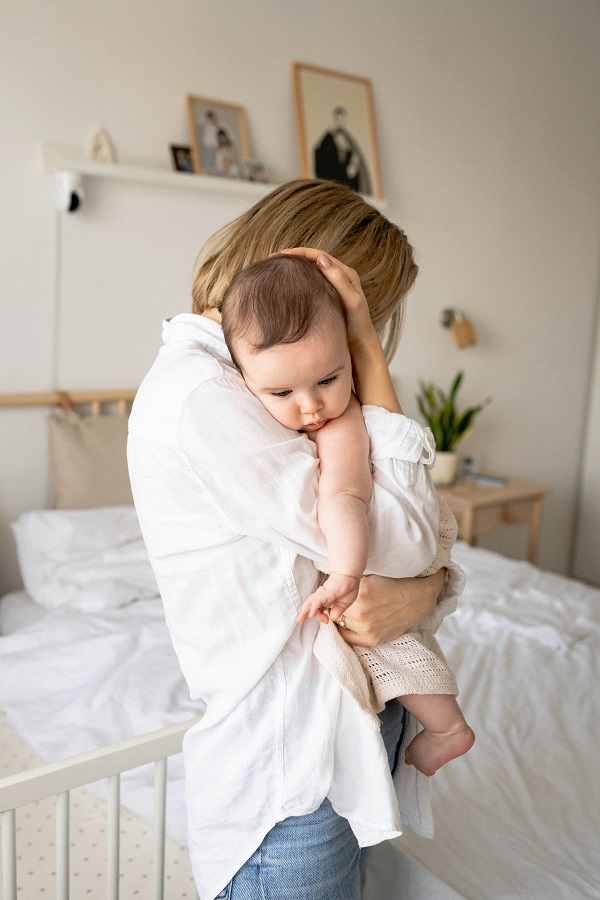Last Updated on January 1, 2025
Moving your baby to their own room can typically be considered around 6 months of age, aligning with recommendations for safe sleep environments and developmental milestones. Begin by ensuring the room is safe and baby-proofed, introduce the baby to the room during playtimes, and gradually start with naps before making the full transition for all sleep times. Remember, every baby is different, so adjust the timing and approach based on your child’s comfort and readiness.

Read More – When Is A Baby No Longer A Newborn?
When And How To Move Baby To Their Own Room?
The journey of parenting is filled with numerous milestones, each marking a significant moment in both the parent’s and child’s life. One such milestone is the transition of your baby from sleeping in your room to moving into their own space. This move is not just a physical shift but also a developmental step forward for your baby. It’s a decision that comes with a mix of emotions – excitement, anticipation, and perhaps a bit of anxiety. But when is the right time, and how do you make this transition smooth for your little one?
The Best Time to Make the Move
The American Academy of Pediatrics (AAP) recommends that infants share their parent’s room for at least the first 6 months and, ideally, for the first year of life. This recommendation is based on evidence that room-sharing can decrease the risk of Sudden Infant Death Syndrome (SIDS) by as much as 50%. However, the exact timing for moving a baby into their own room can vary from family to family, depending on various factors including space, family sleep patterns, and the baby’s development.
By the age of 6 months, many babies have established a fairly consistent sleep routine and are possibly sleeping through the night. This period may be a practical time to consider the transition, as it can benefit both the baby’s and parents’ sleep quality.
Preparing for the Transition
- Safety First: Before making any moves, ensure the baby’s room is safe and secure. This means baby-proofing the room, securing furniture to the wall, and ensuring there are no small objects within the baby’s reach. The crib should meet current safety standards, with a firm mattress and no loose bedding or soft toys.
- Familiarize the Space: Gradually introduce your baby to the new room. Spend playtime there, so the baby starts associating the room with comfort and security. This familiarity will make the overnight transition easier.
- Maintain Sleep Routines: It’s crucial to keep your baby’s bedtime routines consistent. Whether it’s a bath before bed, reading a story, or singing lullabies, these rituals should continue in the new room to signal to your baby that it’s time for sleep.
- Start with Naps: Before making the overnight switch, start by having your baby take daytime naps in the new room. This will help your baby get used to sleeping in the new environment without the pressure of an entire night.
Read More – What To Wear To A Baby Shower: 10 Outfit Ideas & 10 Tips
Making the Move
- Choose the Right Time: Look for a time when your baby is not going through a major developmental leap, such as learning to crawl or teethe. Such milestones can disrupt sleep patterns, making the transition harder.
- Stay Positive and Calm: Babies are incredibly sensitive to their parent’s emotions. If you are anxious about the transition, your baby might pick up on these cues and feel uneasy too. Maintain a positive and calm demeanor to help your baby feel secure.
- Monitor but Don’t Hover: With modern technology, you can keep an eye on your baby without being in the same room. Use a baby monitor to stay connected. This will give you peace of mind while allowing your baby to adjust to sleeping independently.
- Expect Some Setbacks: Transitioning to sleeping in a separate room is a process, and it may not be smooth from the start. There might be nights when your baby will need more reassurance than usual. Be patient and consistent, and remember that it’s okay to comfort your baby if they’re struggling.

Read More – Who Not To Invite To Your Baby Shower?
FAQs
When And How To Move Baby To Their Own Room?
Move your baby to their own room around 6 months, when they often start to sleep more consistently. Begin with safety checks and familiarization with the room, introduce naps there first, and maintain bedtime routines to ease the transition.
When should I transition my baby to his own room?
Transition your baby to their own room around the 6-month mark. This timing aligns with developmental stages and sleep patterns, facilitating a smoother transition while adhering to guidelines that suggest room-sharing for the first 6 months.
At what age should babies sleep in their own room?
Babies should ideally start sleeping in their own room at about 6 to 12 months of age. This range considers the AAP’s recommendation for reducing SIDS risks and accommodates varying developmental readiness and family preferences.
When should baby stop sleeping in bassinet?
Babies should transition from the bassinet to a crib when they reach the bassinet’s weight limit, exhibit the ability to roll over, or by 6 months of age. This ensures they have enough space for movement and continued safe sleep.
When should I switch my baby to a crib?
Switch your baby to a crib around 4 to 6 months, or when they outgrow their bassinet, begin rolling over, or need more space to sleep comfortably. Transitioning at this time supports safer sleep practices as your baby grows.
Conclusion
Moving your baby to their own room is a significant step for both the parents and the child. It marks the beginning of a new chapter in your child’s development toward independence. By approaching this transition with preparation, patience, and a lot of love, you can make this move smooth and successful for your family. Remember, every child is unique, and what works for one may not work for another. Trust your instincts, consult with your pediatrician, and you’ll find the right approach for your baby.

